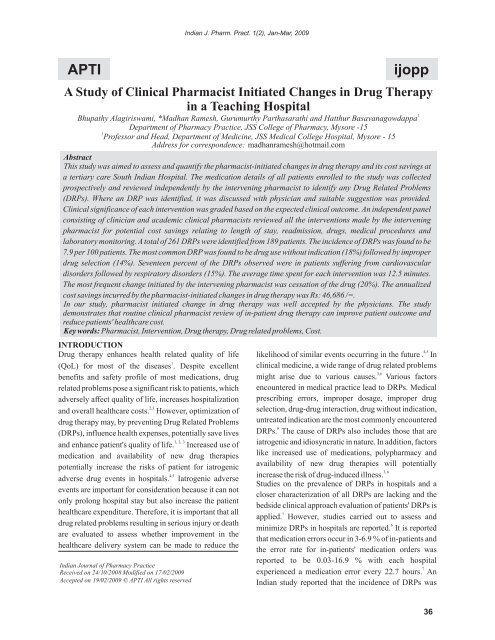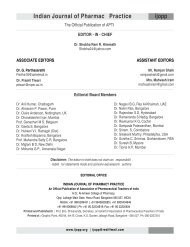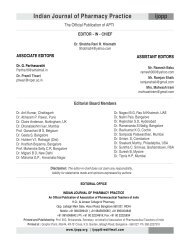<strong>Indian</strong> J. Pharm. Pract. 1(2), Jan-Mar, 2009<strong>APTI</strong><strong>ijopp</strong>A Study <strong>of</strong> Clinical Pharmacist Initiated Changes in Drug Therapyin a Teaching HospitalBhupathy Alagiriswami, *Madhan Ramesh, Gurumurthy Parthasarathi and Hatthur BasavanagowdappaDepartment <strong>of</strong> <strong>Pharmacy</strong> <strong>Practice</strong>, JSS College <strong>of</strong> <strong>Pharmacy</strong>, Mysore -151Pr<strong>of</strong>essor and Head, Department <strong>of</strong> Medicine, JSS Medical College Hospital, Mysore - 15Address for correspondence: madhanramesh@hotmail.comAbstractThis study was aimed to assess and quantify the pharmacist-initiated changes in drug therapy and its cost savings ata tertiary care South <strong>Indian</strong> Hospital. The medication details <strong>of</strong> all patients enrolled to the study was collectedprospectively and reviewed independently by the intervening pharmacist to identify any Drug Related Problems(DRPs). Where an DRP was identified, it was discussed with physician and suitable suggestion was provided.Clinical significance <strong>of</strong> each intervention was graded based on the expected clinical outcome. An independent panelconsisting <strong>of</strong> clinician and academic clinical pharmacists reviewed all the interventions made by the interveningpharmacist for potential cost savings relating to length <strong>of</strong> stay, readmission, drugs, medical procedures andlaboratory monitoring. A total <strong>of</strong> 261 DRPs were identified from 189 patients. The incidence <strong>of</strong> DRPs was found to be7.9 per 100 patients. The most common DRP was found to be drug use without indication (18%) followed by improperdrug selection (14%). Seventeen percent <strong>of</strong> the DRPs observed were in patients suffering from cardiovasculardisorders followed by respiratory disorders (15%). The average time spent for each intervention was 12.5 minutes.The most frequent change initiated by the intervening pharmacist was cessation <strong>of</strong> the drug (20%). The annualizedcost savings incurred by the pharmacist-initiated changes in drug therapy was Rs: 46,686 /=.In our study, pharmacist initiated change in drug therapy was well accepted by the physicians. The studydemonstrates that routine clinical pharmacist review <strong>of</strong> in-patient drug therapy can improve patient outcome andreduce patients' healthcare cost.Key words: Pharmacist, Intervention, Drug therapy, Drug related problems, Cost.INTRODUCTIONDrug therapy enhances health related quality <strong>of</strong> life4,5likelihood <strong>of</strong> similar events occurring in the future . In1(QoL) for most <strong>of</strong> the diseases . Despite excellent clinical medicine, a wide range <strong>of</strong> drug related problemsbenefits and safety pr<strong>of</strong>ile <strong>of</strong> most medications, drug3,6might arise due to various causes. Various factorsrelated problems pose a significant risk to patients, which encountered in medical practice lead to DRPs. Medicaladversely affect quality <strong>of</strong> life, increases hospitalization prescribing errors, improper dosage, improper drug2,3and overall healthcare costs. However, optimization <strong>of</strong> selection, drug-drug interaction, drug without indication,drug therapy may, by preventing Drug Related Problems untreated indication are the most commonly encountered(DRPs), influence health expenses, potentially save lives6DRPs. The cause <strong>of</strong> DRPs also includes those that are1, 2, 3and enhance patient's quality <strong>of</strong> life. Increased use <strong>of</strong> iatrogenic and idiosyncratic in nature. In addition, factorsmedication and availability <strong>of</strong> new drug therapies like increased use <strong>of</strong> medications, polypharmacy andpotentially increase the risks <strong>of</strong> patient for iatrogenicavailability <strong>of</strong> new drug therapies will potentially3, 64,5adverse drug events in hospitals. Iatrogenic adverseincrease the risk <strong>of</strong> drug-induced illness.Studies on the prevalence <strong>of</strong> DRPs in hospitals and aevents are important for consideration because it can notcloser characterization <strong>of</strong> all DRPs are lacking and theonly prolong hospital stay but also increase the patientbedside clinical approach evaluation <strong>of</strong> patients' DRPs ishealthcare expenditure. Therefore, it is important that all 1applied. However, studies carried out to assess anddrug related problems resulting in serious injury or death 6minimize DRPs in hospitals are reported. It is reportedare evaluated to assess whether improvement in thethat medication errors occur in 3-6.9 % <strong>of</strong> in-patients andhealthcare delivery system can be made to reduce thethe error rate for in-patients' medication orders wasreported to be 0.03-16.9 % with each hospital<strong>Indian</strong> <strong>Journal</strong> <strong>of</strong> <strong>Pharmacy</strong> <strong>Practice</strong>Received on 24/10/2008 Modified on 17/02/2009Accepted on 19/02/2009 © <strong>APTI</strong> All rights reserved7experienced a medication error every 22.7 hours. An<strong>Indian</strong> study reported that the incidence <strong>of</strong> DRPs was136
<strong>Indian</strong> J. Pharm. Pract. 1(2), Jan-Mar, 2009found to be greater than quoted as an average in in our study. The exclusion criterion was patients3developed countries . High incidence <strong>of</strong> inappropriate receiving treatments on out-patient basis. Thedosage and improper drug selection observed in the study intervening pharmacist was a postgraduate pharmacywas attributed to lack <strong>of</strong> standard treatment protocols or a practice student. All the interventions made by theformulary for hospital and the differing treatment intervening pharmacist were preceded by consultationpatterns between the medical wards in each <strong>Indian</strong> with the academic clinical pharmacist. The medication3hospital .details <strong>of</strong> all those patients who were admitted to medicalDrug therapy has become so difficult that no one wards were collected and documented in a suitablypr<strong>of</strong>essional is expected to optimize the drug therapy and designed data collection form. The intervening7,8control DRPs alone . Today there exist a due problem in pharmacist, to identify the drug related problems,medical care that urgently requires expert attention reviewed collected data independently. Nature <strong>of</strong> thenamely that <strong>of</strong> preventable drug related morbidity and drug related problem <strong>of</strong> each case that was identified was3,9mortality . These problems could be well preventable / categorized based on categories described by Helper andminimized by initiating changes in drug therapy through9Strand.3clinical pharmacy services . Also, reduction in healthcare Drug related problem identified was brought to the noticecost and improved patient care may be attained through <strong>of</strong> the concerned physician for the remedial action andclinical pharmacy services by ensuring the rational use <strong>of</strong> the primary reason(s) for initiating the intervention wasmedications, and improving patient compliance with recorded. In addition, appropriate suggestions were10medications .provided to the concerned physician at the earliestA study in the United States estimated that the cost <strong>of</strong> possible time. The clinical significance <strong>of</strong> eachtreating conditions caused by inappropriate medication intervention was assessed by the intervening pharmacist,8was US $177.4 billion in 2000. It is reported that due to and later reviewed and verified by an academic clinicalhigh expenditure towards medical expense patients tend pharmacy practitioner for accuracy. The acceptance levelto skip the medication or nonadherence to the medication <strong>of</strong> physician for the particular intervention was alsothat will worsen the disease condition. Pharmacist can recorded as either accepted or not accepted. Similarly,ensure appropriate drug use, decrease out <strong>of</strong> pocket whether or not there was a change in drug therapy was11expenditures, and improves access to needed drugs by noted. After the interventions, further details such asproviding consultation at the point <strong>of</strong> care. In a recent suggestions provided, its category and resources orstudy it is reported that the annualized cost savings references consulted were documented. In addition, therelating to length <strong>of</strong> stay, readmission, drugs, medical total time taken by the intervening pharmacist inprocedures and laboratory monitoring as a result <strong>of</strong> preparing and undertaking the intervention was recorded.clinical pharmacist initiated changes to hospitalized At the time <strong>of</strong> patient discharge, the interveningpatient management or therapy was $ 4 444 794 for eight pharmacist documented the actual changes to drugmajor acute care government funded teaching hospitals therapy and patients' outcomes relating to the2in Australia. Studies exploring cost savings achieved intervention. The involvement <strong>of</strong> pharmacist inthrough the provision <strong>of</strong> clinical pharmacy services to therapeutic decision - making was rated according tohospitalized patients in major acute care teaching Campagna's decision- making model, but forhospital are limited. Moreover, in <strong>Indian</strong> setup, studies simplification.assessing the pharmacist interventions and its cost savingAn independent clinical panel was convened whichhas not been well demonstrated. Hence, this study wasconsisted <strong>of</strong> a consultant physician, final yearintended to assess and quantify the clinical pharmacistpharmacist.All those interventions, which were acceptedpostgraduate medical student and an academic clinicalinitiated changes to drug therapy and its cost savings atJSS Medical College Hospital, Mysore.and changed by the physician, were assessed by the panelMETHODSfor any possible impact on the following: length <strong>of</strong> stayThis prospective study was conducted at a 1000 bed (LOS), readmission probability, medical procedures andmultispeciality tertiary care teaching hospital (JSS laboratory monitoring. The independent clinical panelMedical College Hospital, Mysore) over a period <strong>of</strong> reviewed only those interventions perceived by theseven months. In-patients <strong>of</strong> either sex <strong>of</strong> any age intervening pharmacist as having an impact on eitherundergoing treatment in medicine wards were included length <strong>of</strong> stay, readmission probability, medical37
- Page 1: Indian Journal of Pharmacy Practice
- Page 4 and 5: Indian Journal of Pharmacy Practice
- Page 7 and 8: APTIIndian J. Pharm. Pract. 1(2), J
- Page 10 and 11: Indian J. Pharm. Pract. 1(2), Jan-M
- Page 12 and 13: Indian J. Pharm. Pract. 1(2), Jan-M
- Page 14 and 15: APTIijoppGenesis, Development and P
- Page 16 and 17: Indian J. Pharm. Pract. 1(2), Jan-M
- Page 19 and 20: Indian J. Pharm. Pract. 1(2), Jan-M
- Page 21 and 22: Indian J. Pharm. Pract. 1(2), Jan-M
- Page 23 and 24: Indian J. Pharm. Pract. 1(2), Jan-M
- Page 25 and 26: Indian J. Pharm. Pract. 1(2), Jan-M
- Page 27 and 28: Indian J. Pharm. Pract. 1(2), Jan-M
- Page 29 and 30: Indian J. Pharm. Pract. 1(2), Jan-M
- Page 31 and 32: Indian J. Pharm. Pract. 1(2), Jan-M
- Page 33 and 34: Indian J. Pharm. Pract. 1(2), Jan-M
- Page 35 and 36: Indian J. Pharm. Pract. 1(2), Jan-M
- Page 37 and 38: Indian J. Pharm. Pract. 1(2), Jan-M
- Page 39 and 40: Indian J. Pharm. Pract. 1(2), Jan-M
- Page 41: Indian J. Pharm. Pract. 1(2), Jan-M
- Page 45 and 46: Indian J. Pharm. Pract. 1(2), Jan-M
- Page 47 and 48: Indian J. Pharm. Pract. 1(2), Jan-M
- Page 49 and 50: Indian J. Pharm. Pract. 1(2), Jan-M
- Page 51 and 52: Indian J. Pharm. Pract. 1(2), Jan-M
- Page 53 and 54: pivotal to the rational use of medi
- Page 55 and 56: .leadership” (Cohen, 1984). A stu
- Page 57 and 58: Indian J. Pharm. Pract. 1(2), Jan-M
- Page 59 and 60: Indian J. Pharm. Pract. 1(2), Jan-M
- Page 61 and 62: Indian J. Pharm. Pract. 1(2), Jan-M
- Page 63 and 64: Indian J. Pharm. Pract. 1(2), Jan-M
- Page 65 and 66: Indian J. Pharm. Pract. 1(2), Jan-M
- Page 67 and 68: Indian J. Pharm. Pract. 1(2), Jan-M
- Page 69 and 70: Indian J. Pharm. Pract. 1(2), Jan-M
- Page 71 and 72: Indian J. Pharm. Pract. 1(2), Jan-M
- Page 73 and 74: Indian J. Pharm. Pract. 1(2), Jan-M
- Page 75 and 76: Indian J. Pharm. Pract. 1(2), Jan-M
- Page 77 and 78: Indian J. Pharm. Pract. 1(2), Jan-M
- Page 79 and 80: Indian J. Pharm. Pract. 1(2), Jan-M
- Page 81 and 82: Indian J. Pharm. Pract. 1(2), Jan-M
- Page 83 and 84: Indian J. Pharm. Pract. 1(2), Jan-M
- Page 85 and 86: Indian J. Pharm. Pract. 1(2), Jan-M
- Page 87 and 88: Indian J. Pharm. Pract. 1(2), Jan-M
- Page 89 and 90: Indian J. Pharm. Pract. 1(2), Jan-M
- Page 91 and 92: Indian J. Pharm. Pract. 1(2), Jan-M
- Page 93 and 94:
Indian J. Pharm. Pract. 1(2), Jan-M
















